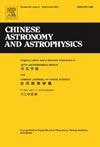A Near-Earth Object Survey Planning and Scheduling Model for Multi-Application Survey Telescope Array
Q4 Physics and Astronomy
引用次数: 0
Abstract
It has become a consensus that near-Earth asteroids (NEAs) threaten global security, thus their detection is of great significance. The Multi-Application Survey Telescope Array (MASTA), with its wide field of view, multiple telescopes, and large aperture, is particularly well suited for NEA detection. Its addition can significantly enhance China's capability in this regard. To leverage MASTA's advantages in NEA detection, we propose a survey strategy for near-Earth objects and present a scheduling model based on the integer linear programming method. To evaluate the model's effectiveness and MASTA's performance in NEA detection under this framework, we generate a synthetic NEA dataset by augmenting the known population and then conduct a one-year survey simulation. The simulation results indicate that the scheduling model can effectively meet the requirements of MASTA's survey for NEAs and optimize the allocation of observational resources while considering other scientific goals. We find that MASTA can achieve a one-year detection completeness of 1.29% for the synthetic NEA population.
一种多用途巡天望远镜阵列近地天体巡天计划与调度模型
近地小行星威胁全球安全已成为共识,对其进行探测具有重要意义。多用途巡天望远镜阵列(MASTA)具有宽视场、多望远镜和大口径,特别适合NEA探测。它的加入可以显著增强中国在这方面的能力。为了充分利用MASTA在近地天体探测中的优势,提出了一种近地天体探测策略,并提出了一种基于整数线性规划方法的调度模型。为了评估该框架下模型的有效性和MASTA在NEA检测中的性能,我们通过增加已知种群来生成一个合成的NEA数据集,然后进行为期一年的调查模拟。仿真结果表明,该调度模型能够有效地满足MASTA对近地天体的调查要求,并在考虑其他科学目标的同时优化观测资源的分配。我们发现MASTA对合成NEA群体的一年检测完整性为1.29%。
本文章由计算机程序翻译,如有差异,请以英文原文为准。
求助全文
约1分钟内获得全文
求助全文
来源期刊

Chinese Astronomy and Astrophysics
Physics and Astronomy-Astronomy and Astrophysics
CiteScore
0.70
自引率
0.00%
发文量
20
期刊介绍:
The vigorous growth of astronomical and astrophysical science in China led to an increase in papers on astrophysics which Acta Astronomica Sinica could no longer absorb. Translations of papers from two new journals the Chinese Journal of Space Science and Acta Astrophysica Sinica are added to the translation of Acta Astronomica Sinica to form the new journal Chinese Astronomy and Astrophysics. Chinese Astronomy and Astrophysics brings English translations of notable articles to astronomers and astrophysicists outside China.
 求助内容:
求助内容: 应助结果提醒方式:
应助结果提醒方式:


